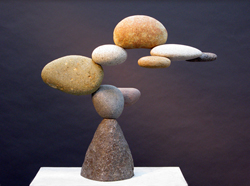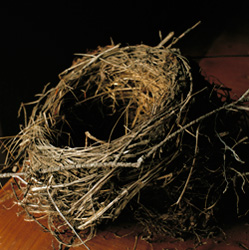October 20 - November 24, 2012
Reception: October 20, 2012 4-6PM
On October 20th, Craig Krull Gallery will open its seventh solo exhibition of Woods Davy’s sculpture. For the past thirty years, Davy has worked with stone in unaltered states, either from the sea or the earth, incorporating them into assemblages of precarious balance that appear to be in flux. Art writer Shana Nys Dambrot observed that Davy’s work is essentially a “kind of collaboration between artist and nature,” one in which the artist “prefers to cooperate with the pre-existing uniqueness and objecthood of his materials.”
In this body of work, Davy has carefully selected stones that have been rounded and smoothed by the tumbling effects of the Pacific at a beach in Mexico called Cantamar (which means “song of the sea”). Davy’s sculptural assemblages form cantilevered arcs which appear to float or roll like the waves that shaped them. In larger works, these stones are combined with vertically oriented, rough granite boulders pulled from the earth. As Holly Myers remarked in the LA TIMES, there is “something thrilling about a work that appears to defy its own natural properties,” while at the same time one can appreciate the work’s “meditative reverence.”
On October 20th, Craig Krull Gallery will present its sixth solo exhibition of photographs by Wendy Burton with a new series entitled, Natural Histories. In a previous body of work entitled Trace Elements, Burton photographed remnants of human life left behind in the natural landscape. With Empty Houses and Rust Belt, she continued her exploration of abandoned spaces, both domestic and industrial. Natural Histories continues the theme of once inhabited dwellings with photographs of deserted bird nests. Burton notes that each nest is “a small miracle of architecture and engineering…each somehow perfect, even in its imperfection.” This project also includes images of animal skulls, crustacean casings, snake skeletons and other remnants of once living creatures, further developing her investigations into “that which is left behind.” All of the subject matter is photographed as a singular object, on a wooden table, within a relatively dark interior lit by a single source of natural light. They are still-lifes in the tradition of memento mori, but more importantly, they reflect the artist’s reverence of natural form and meditations on how these forms were shaped by instincts and evolution.

